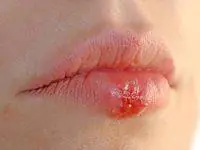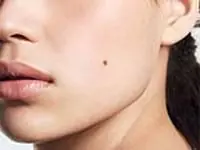Neurodermatitis is a neurogenic-allergic disease characterized by intense itching, papular rash and nervous system disorders (depression, panic attack, hysterical syndrome). It affects mainly children of preschool and school age, as well as young people under 18 years of age. In adults, neurodermatitis rarely develops; more often it occurs as an exacerbation of a chronic pathological process, due to an incompletely cured acute reaction of the body in childhood. Read more about neurodermatitis in children in this article.
What is neurodermatitis?
The second name of the disease is atopic dermatitis, which is manifested by hypersensitivity to allergens, exudative and lichenoid rashes, as well as an increase in the level of IgE in the blood serum. Lichenoid rash is flat, shiny papules of a purple hue, and exudative rash is where vesicles with serous contents form in the center of the focal lesions. There is a clear seasonal dependence: in winter there are exacerbations or relapses, and in summer there are complete or partial remissions.
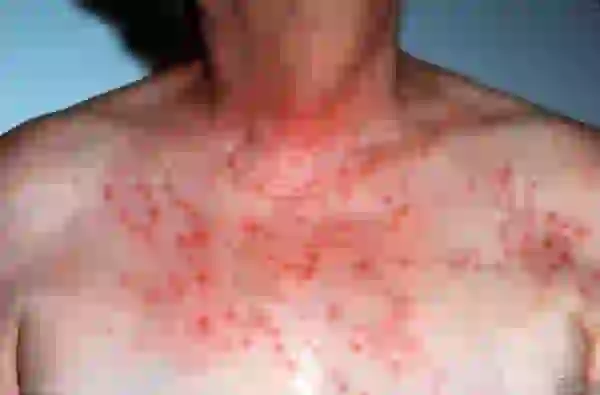
The following factors contribute to the formation of neurodermatitis:
- Hereditary predisposition.
- A child's likelihood of developing allergies increases by 80% if both parents had allergic rashes in childhood. Even in healthy families, in 10 cases out of 100 children are born with neurodermatitis.
- The child suffered from eczema at an early age
Increased sensitivity of the body to drugs, pollen, and food.
Presence of allergic diseases (bronchial asthma, vasomotor rhinitis).
Neurodermatitis is not contagious, so it is not transmitted through handshakes or household items.
Causes of the disease
The main reason for the formation of skin rashes is delayed allergic reactions. They arise due to the high content of class E immunoglobulins, which are inherent in the human body at the genetic level. When any allergen enters the bloodstream, an inadequate immune reaction quickly occurs, involving the skin and nervous system in the chemical process.
Science puts forward a neurogenic theory of the development of the disease. Scientists consider neurodermatitis as a skin neurosis, because this is evidenced by exacerbation of symptoms due to nervousness - under severe stress, neuropsychic trauma, and vasomotor disorders. Skin reactions occur as a result of a violation of the body's adaptive stability during stressful situations.
Internal causes of neurodermatitis include:
- metabolic disease;
- nervous overstrain leading to a malfunction of the central nervous system;
- gastrointestinal diseases;
- poor nutrition;
- inflammatory processes in the body;
- weakened immunity.
The causes of external influences that cause allergic reactions are considered:
- medical supplies;
- pet food;
- chemicals found in household chemicals and decorative cosmetics;
- traffic fumes;
- contaminated drinking water;
- pollen of flowers, trees and grasses;
- poor quality food.
Only after determining the specific cause that caused the neurogenic-allergic reaction can treatment begin.
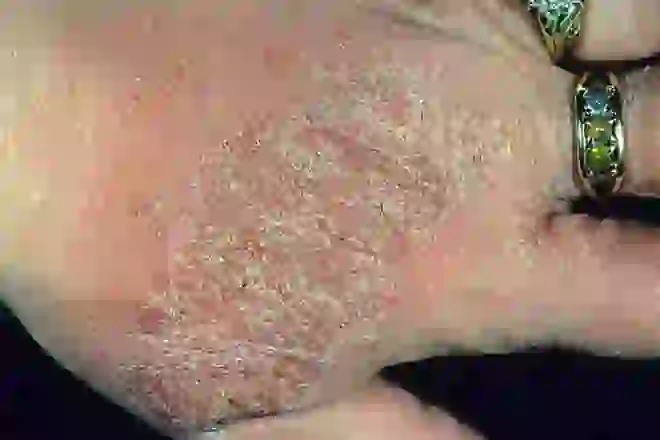
Forms of neurodermatitis
Dermatologists distinguish several types of allergic diseases, which are classified according to the degree of prevalence based on human skin.
Limited form
More often, limited neurodermatitis is diagnosed, affecting small areas of the skin - the neck area, popliteal cavities, elbow fossae, anus and genital area, details here. Small papular formations of regular round shape are located symmetrically. Focal neurodermatitis ranges from pink to brown in color and is characterized by dry skin, infiltration and increased skin pattern. No weeping is observed.
Diffuse form
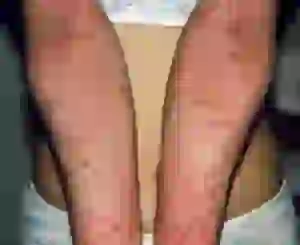
This type of disease is considered severe, as multiple lesions occur. Favorite localization is the upper and lower limbs, torso, face, neck, genitals. Lichenified and infiltrated affected areas of the skin merge with each other. In some places, flat nodules with a shiny surface form. If the patient scratches the rash vigorously, it may become wet for a short time, which increases the risk of tissue infection. The skin looks swollen and red, covered with small scales. In children, the disease can affect the scalp and area around the eyes.
Hypertrophic neurodermatitis
The occurrence of this form of the disease is a consequence of the degeneration of epidermal cells. The pathological process is localized in the inguinal-femoral folds and on the inner surface of the thighs. Wart-like growths may form in the affected area, causing paroxysmal itching.
Psoriasiform form
The rashes look like compacted red lesions covered with whitish small scales, as with psoriasis. More often they occur on the neck or head (nape area).
Linear neurodermatitis
The disease affects the flexion areas of the upper and lower extremities. The rashes are severely inflamed, unbearably itchy and crusty. The skin is highly susceptible to cracking, so there is a risk of secondary infection.
Follicular neurodermatitis
Favorite localization is the scalp. The papular rash has a pointed appearance and is located towards the mouths of the hair follicles.
Decalving form
The disease affects all parts of the body covered with vellus hair. Subsequently, painful hairs atrophy and fall out.
Any form of neurodermatitis requires a comprehensive diagnosis and an individual treatment regimen, taking into account the general condition of the patient.
Symptoms of the disease
The initial stage of neurodermatitis is manifested by itching and dry skin in the expected areas of future rashes. Afterwards, the skin acquires a reddish tint and begins to peel off.
In the acute phase of the disease, the following symptoms of neurodermatitis predominate:
- formation of small nodules (papules) on the skin;
- soreness of the affected areas after taking water procedures;
- strengthening of skin pattern;
- darkening or lightening of skin color;
- weeping with the formation of crusts.
With the appearance of the rash, patients begin to experience severe itching of the affected areas of the skin. It is most pronounced at night.
Advanced neurodermatitis leads to the appearance of secondary symptoms of the pathological process. Insomnia, fatigue, apathy, and weight loss occur. Due to disruption of the functioning of other organs, a decrease or increase in blood pressure, enlargement of lymph nodes and secretion of gastric juice are observed.
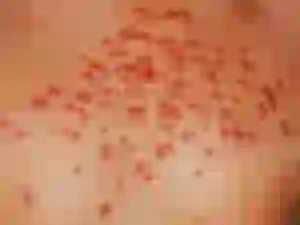
Patients with neurodermatitis are characterized by white dermographism - a perverted vascular reaction. When you run a finger or other non-sharp object across a person’s skin, a white stripe remains for a long time (more than 5 minutes). This condition occurs due to vasospasm under the influence of the nervous system.
The greatest psychological discomfort is experienced by people whose arms, especially their hands, are affected by rashes. The fact is that these zones are subject to strong mechanical stress and often come into contact with moisture, provoking an aggravation of the pathological process.
How to diagnose neurodermatitis?
First of all, the dermatologist pays attention to the patient’s family history and complaints, then a visual examination of the skin is performed. Important diagnostic criteria are: severe itching even with the slightest manifestations on the skin, typical localization and morphology of the rash, increased levels of immunoglobulin E in the blood.
The doctor prescribes the following diagnostic tests:
- general blood analysis;
- blood for determination of immunoglobulins;
- dermatoscopy;
- Ultrasound of skin and fatty tissue.
For extensive skin lesions with severe oozing, a skin biopsy is required. To determine the allergen that irritates the immune system and provokes the disease, skin tests are performed.
How to treat neurodermatitis?
Before you begin to treat the disease, you need to stop contact with the identified allergens. If the irritant cannot be identified, then all possible allergenic agents are excluded from the patient’s living environment, including food.
The primary goal of treatment is to eliminate the inflammatory skin reaction and unbearable itching. Then it is necessary to achieve normalization of the nervous system and restoration of the skin structure. At the same time, the doctor prescribes therapy for concomitant diseases that aggravate the course of neurodermatitis (obesity, diabetes mellitus).
Drug therapy
Drug treatment begins with taking antiallergic drugs. In severe cases, preference is given to injectable forms - Chlopyramine, Clemastine; in mild forms of the disease, tablets are taken - Suprastin, Loratadine. Medicines help eliminate itching and prevent the occurrence of new rashes.
To reduce the likelihood of developing neurotic reactions, patients are recommended to take drugs with a sedative effect, and in case of developed central nervous system disorders, tranquilizers and antidepressants. The simplest medicine for nerves, which helps with insomnia and irritability, is considered to be tincture of valerian root. Stronger drugs with similar effects are peony tincture, Sedavit, Persen, Novo-Passit.
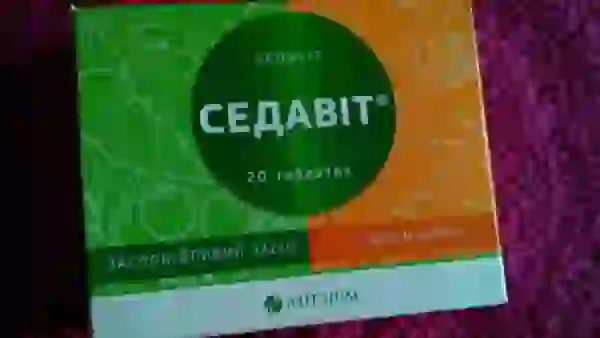
If it is necessary to normalize the functioning of the gastrointestinal tract, patients take probiotic (Linex), enzymatic (Mezim) and hepatoprotective (Karsil) drugs. In order to eliminate the symptoms of intoxication of the body, a course of therapy with activated carbon or Enterosgel is prescribed.
If it is not possible to relieve the patient of unpleasant symptoms, and the proposed therapy cannot achieve the desired results, then external or systemic glucocorticosteroids, as well as combined topical hormonal preparations based on betamethasone, are used. More often, dermatologists prescribe Advantan or Dermovate ointment.
To get rid of neurodermatitis forever, it is necessary to undergo a course of specific allergen immunotherapy (ASIT) during the period of remission. The essence of the method is to dose the body with purified preparations from the allergen considered to be the cause of the disease, so that the body can develop immunological tolerance to the substance. Treatment is indicated for adults and children in whom it is impossible to eliminate contact with the irritant.
General therapeutic measures
Treatment of neurodermatitis is carried out comprehensively, so patients are advised to follow the following rules:
- adhere to a strict hypoallergenic diet in the acute phase of the disease, then the diet can be expanded;
- exclude contact with pets, as well as disinfect the living space where they were located;
- remove aquariums, flowering plants, carpets, feather pillows and blankets, antique books, soft toys from the living space;
- use clothing and personal items made from natural fabrics;
normalize the daily routine; - avoid stressful situations.
Physiotherapeutic procedures have a positive effect in getting rid of neurodermatitis. Doctors recommend taking courses of ultraviolet irradiation, paraffin treatment, magnetic therapy, laser therapy, and mud therapy. Water procedures play a special role. Nitrogen-thermal, radon and iodine-bromine baths effectively eliminate itching and flaking.
Forecast
The disease in most cases occurs in waves. In approximately 60% of patients, allergy symptoms disappear completely, but only with adequate treatment and timely diagnosis in the early stages of the pathological process. The rest of the patients experience recurrent rashes throughout their lives.
Severe forms of neurodermatitis progress to the chronic stage and entail numerous complications.
Complications of neurodermatitis
Long-term use of hormonal ointments for the treatment of neurodermatitis entails the occurrence of recurrent bacterial, viral and fungal infections. Folliculitis, furunculosis, impetigo, hidradenitis are the most common manifestations of infection with Staphylococcus aureus or white Staphylococcus. If a fungus gets on the affected areas of the skin, then neurodermatitis is complicated by candidal cheilitis.

Often, warty neoplasms form in the area of the disease, which are mainly localized on the sole, back of the hands and in the inguinal folds.
The most severe complication is Kaposi's eczema herpetiformis, provoked by the herpes simplex virus. Eczema is characterized by the appearance of pustules and vesicles on areas of the skin affected by neurodermatitis. The rashes are abundant, round in shape, protrude above the surface of the skin and have a small depression in the center. The elements are protected from healthy skin by a roll of inflamed epidermis.
Prevention of neurodermatitis
Primary preventive measures to prevent the development of neurodermatitis include preventing sensitization in early childhood. Particular attention should be paid to children who have a family history of parental allergies.
A child prone to allergic reactions is prescribed a strict elimination regimen, which is aimed at destroying or reducing contact with allergens. Living conditions should be hypoallergenic, so parents should get rid of sources of dust accumulation, use air purifiers, and carry out daily wet cleaning in the apartment.
To prevent relapses of the disease, it is necessary to normalize the functioning of the nervous system. To reduce psychological stress, it is advisable to attend yoga, dance, or arts and crafts classes. Salt dough modeling, bead weaving, skiing, and hiking can improve your mood and help you cope with stress.
Neurodermatitis (or atopic dermatitis, or diffuse neurodermatitis) is a chronic inflammatory disease - allergic dermatitis, affecting the skin of people with a predisposition in the genome, as well as a disorder of the immune status, nervous and endocrine systems, and the functionality of other organs.
The presence of congenital heart abnormalities, clubfoot, hernias, cataracts, etc. in patients also indicates a hereditary factor of atopic dermatosis. Neurodermatitis has a persistent chronic, often recurrent nature, differing in form depending on age, causes, symptoms, as well as the season of the year.
The leading role in the occurrence of neurodermatitis belongs to the nervous system. Synonym for atopic dermatitis. Nowadays the term “atopic neurodermatitis” is also used. The mechanism of development of the disease is neuroendocrine. The consequence of diathesis is transition to childhood eczema - pruritus - neurodermatitis.
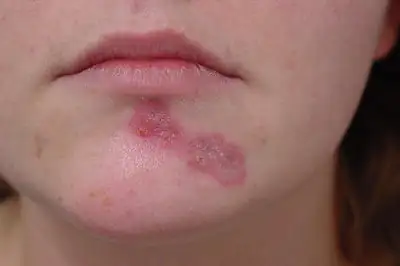
What it is?
Neurodermatitis is an inflammatory skin disease that occurs due to endogenous (occurring within the body) causes. It occurs mainly in childhood and adolescence, often becomes chronic and is one of the most common dermatological diseases on the planet.
Causes of the disease
Neurodermatitis is not a contagious disease. Often its root cause is a genetic predisposition to allergies. The human body can react with illness to any irritant - from the fur of a pet to your favorite cosmetic product.
Experts believe that common causes of neurodermatitis are:
- neuropsychiatric health disorders;
- medications;
- climatic factors;
- work in hazardous conditions and other irritating factors;
- poor nutrition, general toxic pollution of the body;
- prolonged psycho-emotional, mental and physical overload, depression;
- profound disturbances in the functioning of the immune, central and peripheral nervous systems, vegetative-vascular syndrome;
- sources of chronic infection, foci of inflammation in the body and bacterial accumulations on the skin;
- gastrointestinal diseases associated with disorders of fermentation processes, disruptions in the endocrine system, ENT diseases;
- genetic determination of the tendency to various allergic reactions, which is proven by the high intensity of diseases of close relatives and identical twins;
- endogenous factors - a polluted state of the surrounding external (street) and internal (indoor) environment, which can cause skin hyperreactivity.
Despite the variety of factors that provoke the development of neurodermatitis, dermatologists believe that the disease triggers an allergic mechanism. At the first meeting with an allergen, the body produces antibodies to a new compound, but the second time the antibodies combine with the body and are carried through the bloodstream to all tissues and organs and destroy the membranes of their cells.
During the process of degranulation, active substances are released, among which is histamine. This substance causes redness and thickening of the skin, an increase in local temperature and a feeling of itching or burning. In case of secondary infection, body temperature rises.
Scientists explain damage to the nervous system as the cause of neurodermatitis by dysfunction of peripheral nerve fibers. Therefore, the patient begins to experience severe itching, and rashes appear on the body. The desire to scratch the skin leads to injury, increased intensity of itching and swelling of the tissue.
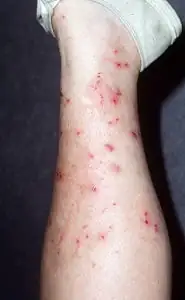
Classification
Neurodermatitis is a disease that has several types, which determine the extent of the pathological process in the patient’s skin.
- Diffuse neurodermatitis. This form is characterized by the appearance of multiple lesions. As a rule, they are localized on the upper and lower extremities (in the popliteal cavities and elbow bends), as well as on the torso. However, diffuse neurodermatitis often affects the neck, genitals, anus and face. In this case, the lesions are merging lichenified and infiltrated skin areas. In some places, in addition to lichenification, flat shiny nodules appear. Sometimes patients experience short-term weeping after scratching. As a result, the lesions can become infected, complicated by lymphadenitis or pyoderma. Patients suffering from diffuse neurodermatitis are characterized by swelling and hyperemia of the skin, often covered with small scales.
- Limited neurodermatitis. This type of neurodermatitis is characterized by the appearance on the surface of the skin of plaques covered with nodular neoplasms on the neck, in the knee and elbow bends, in the perineum, and on the genitals. With this type of disease, a symmetrical arrangement of plaques is often noted. As a rule, they appear simultaneously on both elbows, knees, and feet.
- Decalvating affects hairy areas of the body, causing gradual hair loss.
- Linear neurodermatitis. This is a pathology in which the lesions are localized mainly on the extensor surfaces of the arms and legs and have the shape of stripes, sometimes with a warty or flaky surface.
- Follicular: formed on the scalp of the body in the form of rashes that look like pointed papules.
- Psoriasiform neurodermatitis. In this case, the lesions are red lumps covered with small silvery-white scales. Most often they are localized on the head and neck.
- Hypertrophic: expressed in swelling in the area of the lymph nodes, most often the inguinal ones.
Each type of neurodermatitis brings significant discomfort to a person, so treatment is required without delay.
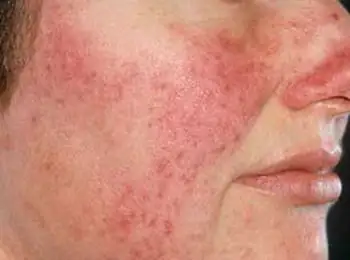
Symptoms of neurodermatitis
The main symptoms of neurodermatitis in adults and children are characterized by rash, itching, neurotic disorders, redness, and peeling. Moreover, the area of distribution of the disease can be varied depending on its specific variety.
With neurodermatitis, the function of the adrenal glands is significantly reduced, so the skin may darken noticeably. A person loses weight, which negatively affects the general condition of the body. Blood pressure decreases, fatigue, apathy and weakness increase, gastric juice secretion and blood glucose levels decrease. Neurodermatitis sometimes leads to lymphadenitis (inflammation of the lymph nodes), which impairs the functioning of many organs.
It should be noted that the symptoms of neurodermatitis are most pronounced in the winter and in the evening, and in the summer, on the contrary, noticeable improvements are felt. Neurodermatitis on the hands brings the greatest discomfort, since moisture and frequent mechanical stress only worsen the disease.
What does neurodermatitis look like, photo
The photo below shows how the disease manifests itself in adults and children.
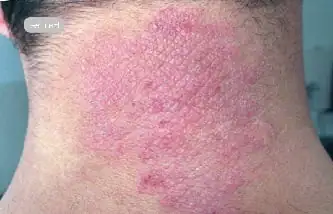
How to diagnose correctly?
Diagnosis of neurodermatitis is carried out by a dermatologist at the first visit. To do this, the patient’s complaints and examination of his body are enough. To confirm the diagnosis, the patient may be prescribed laboratory and biochemical tests: his blood is checked for the number of leukocytes and eosinophils.
Most patients exhibit eosinophilia and leukocytosis, and immunological studies show an increased amount of IgE immunoglobulins. When secondary diseases occur, treatment of neurodermatitis and its symptoms can be adjusted in accordance with the overall clinical picture.
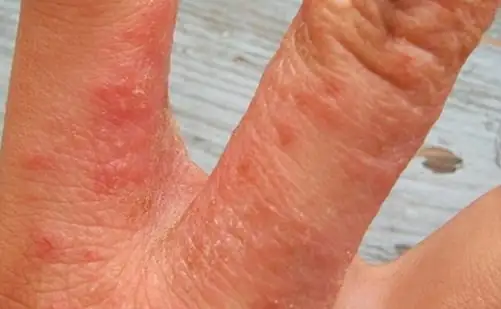
How to treat neurodermatitis?
Often neurodermatitis is treated in a very truncated manner and attention is paid only to skin manifestations. For relief of which local treatment is directed. However, it is worth considering the process as a whole and paying attention to all stages of treatment.
- Diet. Therapy begins, especially in the case of children, with dietary measures. It is ideal when it is possible to identify the main allergens that provoke the process and eliminate them from food. In adults, therapy also begins with the introduction of a diet with limited alcohol and spices. They try to breastfeed children or switch them to cow protein hydrolysates.
- General mode. Normalization of the general regime should include a full night's sleep (and for children, daytime sleep), sufficient time in the fresh air and rational mental and physical stress, excluding overwork and overexcitation of the nervous system. Treatment of neurodermatitis in adults with total lesions, localization on the palms, secondary purulent complications can be carried out on an outpatient basis with the issuance of a certificate of incapacity for work.
- Treatment of dysbiosis. During periods of exacerbation, it is also recommended to correct dysbiosis and start taking a course of enterosorbents (Enterosgel, Polyepana). It is not advisable to use sorbents on an ongoing basis, since they lead to the removal from the intestines of not only allergens, but also vitamins, which are quite difficult to replace due to dietary restrictions and intolerance to synthetic analogues.
- Sedatives. If necessary, patients are prescribed courses of sedatives or drug therapy for more severe neurological or mental problems.
General recommendations for neurodermatitis that can be performed at home:
1) The most important thing is to stop constantly scratching your skin. No treatment will be effective if the patient continues to scratch the lesions. For this:
- cut your nails short
- At night during an exacerbation, wear cotton gloves on your hands or sleep in cotton pajamas. This will reduce involuntary scratching during sleep.
2) It is very important to avoid contact with allergens that cause aggravation. For this:
- hypoallergenic diet required
- New clothes should be pre-washed.
- You should use soap-based laundry detergents
- clothes should be rinsed thoroughly
- Wet clean the house daily
3) Reduce dry skin. For this:
- Use creamy soaps and detergents with a moisturizing effect.
- water procedures should be short-term (5-10 minutes), in warm (not hot) water.
- After washing or swimming in the pool, apply body cream or milk to your body.
- Loose clothing made of pure cotton should be worn.
- It is advisable to abandon woolen clothes and woolen blankets, replacing them with clothes and blankets made of other materials.
Treatment tactics for neurodermatitis are aimed at eliminating the disorders that provoked the development of the pathological process, as well as at preventing relapses and prolonging remissions.
Drug treatment
The antiallergic niche of therapy involves the use of antihistamines, in most cases 2 and 3 generations of drugs, which have a less inhibitory effect on the central nervous system and at the same time stabilize mast cells and at the same time block the effect of histamine, but first generation drugs are still actively used. They have a relatively quick effect and cause drowsiness, which is actually not bad in the presence of itchy dermatosis.
- First generation: Fenistil in tablets or drops (Demitenden), Tavegil (Clemastin), in tablets or injections Pipolfen (Promethazine), Fenkarol (Hifenadine), Suprastin (Chlorpyramin).
- The second generation drug, Ketotifen (Zaditen), is preferable when a skin process is combined with bronchial obstruction.
- Third generation drugs: Astelong, Astemizole, Akrivastine, Acelastine, Allergodil, Gistalong, Histim, Claritin, Clarisens, Loratadine, Levocabastine, Semprex, Telfast, Terfenadil, Teridine, Cytherizine, Ebastine.
Glucocorticoids are used in severe cases of a common process during periods of exacerbation or the presence of allergic complications in the form of acute allergic reactions (urticaria, Quincke's edema).
- Natural: cortisone, hydrocortisone.
- Semi-synthetic corticosteroids: dexamethasone, triamcinolone, prednisolone.
Treatment with ointments with glucocorticoids is carried out once a day. Apply a thin layer, do not rub in. When taken as a course, they do not cause systemic side effects (Cushing's syndrome, adrenal insufficiency, skin atrophy and diabetes mellitus). When taken for years, the body's own release of adrenal hormones gradually decreases and systemic side effects develop.
- Weak strength drugs: non-fluorinated: hydrocortisone ointment, methylprednisolone aceponate.
- Moderate strength. Non-fluorinated: Laticort, Lokoid. Fluoridated: “Afloderm”, “Ftorokort”, “Triacort”, “Esperson”, “Lokakarten”, “Lorinden”.
- Strong. Fluorinated: “Dermovate”, “Cutivate”, “Beloderm”, “Celestoderm”, “Sinalar”, “Flucinar”, “Sinaflar”. Unphotorated: “Elokom”, “Advantan”.
The main task of non-hormonal drugs is to dry the skin (Zinc ointment or paste, Ski-derm) and have a softening effect (Gistan). However, some drugs also have an anti-inflammatory effect (Apilak, drugs based on tar and ichthyol), and also reduce itching (Elidel, Glutamol). They also use healing ointments (Bipanten, Panthenol).
Autosera are made from the patient’s own blood, which is collected at the peak of an exacerbation of neurodermatitis. Thus, the patient receives antibodies against allergens.
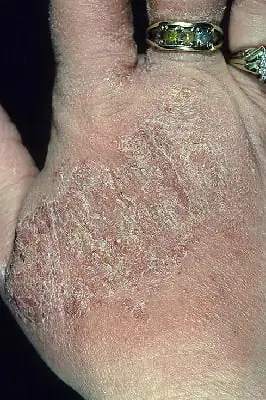
Physiotherapeutic treatment
A procedure such as phototherapy (using a quartz lamp, UV irradiation or selective phototherapy) has proven itself very well in the treatment of neurodermatitis. Selective phototherapy, which involves the use of UV rays with a wavelength of 315-320 nm, is indicated for patients suffering from neurodermatitis only during the period of remission of the disease. The duration of the course of treatment is 15-20 procedures.
Also, as a physiotherapeutic treatment for neurodermatitis, dermatologists recommend cryomassage (use of liquid nitrogen) and irradiation of lesions with a medical laser.
At the same time, sanatorium-resort treatment (on the coast of the Black and Dead Seas) has a very beneficial effect on the patient’s body.
Folk remedies
Based on natural ingredients, you can prepare various home remedies to successfully combat skin ailments. This:
- Lotions, baths, rubdowns. For various treatments of inflamed areas of the skin and for lotions, herbal decoctions with an anti-inflammatory and soothing effect are ideal. Well proven: chamomile, string, oregano, nettle, pine needles, thyme, plantain, mint. You can make both one-component infusions and decoctions from a collection of herbs.
- Creams, ointments. Most often, to prepare an ointment, pork fat/lard is used as a fatty base; it must first be melted and purified sulfur added until a homogeneous mass is obtained. Before use, thoroughly clean the affected areas with baby soap.
- Another homemade ointment recipe that can be prepared from any bird fat, beeswax, and birch tar. Mix all components, place in a ceramic container and leave for 4 hours in a warm place or on a heated surface.
- Compresses. Blue clay, which can easily be purchased at a pharmacy or cosmetic store, has proven itself to be very positive in the treatment of illness. The clay should be mixed with sea salt in equal proportions, add water and apply this slurry in an even layer to the affected areas. Next, you need to wait until the mixture dries and carefully rinse with warm water.
Nutrition rules
A diet for neurodermatitis in adults involves avoiding salt, hot and spicy foods, and foods containing large amounts of carbohydrates. In the acute period, foods with a high index of allergic activity are excluded from the diet:
During the period of exacerbation, you should avoid eating fatty meats and fish, fast food, canned food, and products containing artificial colors and flavors.
The emphasis in nutrition is on following a dairy-vegetable diet. It is healthy to eat fresh vegetables and fruits, salads with vegetable oil, and dairy products. It is recommended to drink more fluid (up to 2 liters per day). The diet includes boiled dietary meat, cereals, vegetable purees, and low-fat broths. It is better to replace sugar with xylitol or sorbitol. The preferred drinks are green tea, rosehip decoction, compotes, and mineral water.

Prevention
Prevention of neurodermatitis looks the same as prevention of any disease. Proper balanced nutrition, moderate physical activity, hardening and increasing immunity, avoiding stress. Dermatologists advise people prone to dermatological diseases to wear clothes made from natural materials that do not irritate the skin, so as not to provoke the development of the disease.
Also, during periods of remissions and exacerbations, you should not expose your skin to any irritants, for example, by doing peelings, scrubs, or using creams labeled “slimming” that contain substances that irritate the skin - pepper, cinnamon, menthol. And finally, it is important to protect sensitive skin from high and low temperatures.
Forecast
Since neurodermatitis does not threaten dangerous complications, the prognosis is the most favorable for life, although complete recovery does not occur in all cases. When the cause of neurodermatitis lies in deep allergic-genetic structures, it is impossible to exclude relapses, because therapeutic measures may not cover all manifestations of the disease.
Diffuse neurodermatitis with severe exacerbations can lead to long-term loss of performance. Limited neurodermatitis does not tend to become diffuse, which is why its prognosis is much more favorable.
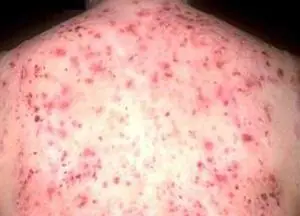
Neurodermatitis is a chronic skin disease, the appearance of which is influenced by various neurogenic and allergic factors. This pathology refers to those dermatological pathologies that can develop from early childhood and subsequently recur throughout life. Among all skin diseases, 40% of cases are neurodermatitis. The disease is characterized by severe itching, as well as characteristic rashes on the skin.
The main reasons for the appearance
The most common factors influencing the occurrence of neurodermatitis are:
- inflammatory diseases of the body;
- metabolic disease;
- decreased immunity;
- diseases of the gastrointestinal tract;
- intoxication of the body;
- physical exhaustion;
- eating disorder;
- bad habits;
- psychological and nervous disorders (stress, neuroses, depression);
- hereditary predisposition.
Prolonged overstrain of the nervous system and dysfunction of the endocrine glands become the background for allergic manifestations and neurodermatitis. Most allergic reactions occur due to heredity.
In adults, neurodermatitis on the hands often occurs against the background of eczema suffered in childhood. Over a long period of time, various forms of eczema can develop into neurodermatitis. Due to chronic diseases of the gastrointestinal tract, accompanied by stool disorders, limited neurodermatitis in the anal area may occur. It can also appear in the presence of worms, hemorrhoids, and anal fissures.
Symptoms of the disease
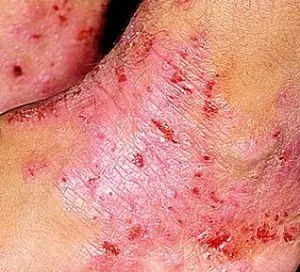
This disease has its own distinctive signs, which are limited mainly to manifestations on the upper areas of the skin. Most often, the inflammatory process is localized on the face, neck, wrists, joint bends and natural folds of the body, and genitals.
In the acute stage of the disease, characteristic severe skin itching appears. It is especially intense at night. First, red spots appear, the edges of which are blurred. For some time, the lesions do not visually change, but in the process of regular scratching, small and noticeable nodular rashes appear, which often peel off and can subsequently merge.
When scratching, a secondary infection may occur, against the background of which erosions, weeping crusts, and pustules (fragments of rashes that are a bubble of liquid) occur. The tissues swell and the skin swells.
With neurodermatitis, the function of the adrenal glands is impaired, which can lead to hyperpigmentation of the skin. The patient feels weakness, increased fatigue, apathy, and his blood pressure drops.
The stages of exacerbation and remission in this disease are mainly seasonal. In winter, the disease process worsens, and in summer, the main symptoms subside and the patient’s condition improves. Sometimes, during the remission stage, depigmented areas of skin appear in the affected areas.
Neurodermatitis in adults
Each adult has different manifestations of this disease. There are several forms of neurodermatitis, depending on the degree of skin damage and the processes of its development.
Limited neurodermatitis characterized by the appearance of rashes that are localized in one separate area. The locations of the lesions are concentrated mainly in the elbow and popliteal folds, the inner thighs, legs, scrotum, anus, etc.
Hypertrophic (Ehrmann's neurodermatitis) – not a common form, in which inflammatory processes are localized on the inner femoral region and are tumor-like in nature. Often the disease process is accompanied by the appearance of wart-like formations.
Linear neurodermatitis - a type of disease in which the sites of inflammation fall mainly on the extensor surfaces of the lower and upper extremities, shaped like stripes. The surface is often warty or flaky.
Follicular form differs in the location of the rashes along the hair follicles. Papules are pointed in shape.
Depigmented neurodermatitis characterized by the appearance of loss of skin pigmentation in areas of inflammation.
Psoriasiform neurodermatitis Distributes mainly to the head and neck. The rashes look like compacted redness covered with small scales.
Diffuse neurodermatitis, which is also called atopic, is a more severe form of the disease. It is characterized by multiple lesions. They mainly occur on the upper and lower limbs, torso and other areas. After severe itching, highly pigmented areas and thickening appear. The skin becomes dry and brownish.
With each type of disease, the body experiences noticeable discomfort. But they all require timely treatment to avoid complications later.
All the details about how to cure herpes on the lips are written on our website.
What causes wen to appear on the body, you can read an interesting article at this address.
Treatment of neurodermatitis in adults
A universal treatment system that can completely rid a person of this disease does not exist today. The therapeutic methods prescribed by the doctor depend on the causes, the degree of manifestation of the disease, the individual characteristics of the patient, and the presence of complications. How to treat neurodermatitis?
The main directions of treatment are:
- regulation of the daily routine, physical activity;
- dietary nutrition;
- taking medications (including external ones);
- physiotherapy.
Drug therapy
Treatment of neurodermatitis is complex, and in most cases includes taking drugs from different groups of effects:
- antihistamines - relieve itching, prevent further spread of the rash to healthy skin;
- enzyme preparations that normalize the functioning of the gastrointestinal tract;
- drugs that restore central nervous system function;
- vitamins of group B, A, E, P;
- local remedies (ointments, creams).
The following are used as antipruritic drugs (the price is the average for Russia):
- Tavegil (139 rubles);
- Suprastin (129 rubles);
- Diphenhydramine (5.5 rubles).
To normalize the activity of the central nervous system, tranquilizers are prescribed:
- Seduxen (24 rubles for 24 tablets);
- Elenium (25 tablets 395–515 rubles).
Limited neurodermatitis is treated with ointments with corticosteroids:
- Lorinden (251 rubles for 15 g);
- Flucinar (198 rubles for 15 g);
- Hydrocortisone ointment (2.5 g 90 rubles).
To correct enzyme deficiency and restore microflora, the following drugs are prescribed:
- Pancreatin (30 rubles per pack);
- Mezim (259 rubles for 20 tablets);
- Panzinorm (198 rubles for 30 pieces);
- Festal (192 rubles for 40 tablets).
For the treatment of dysbacteriosis the following is used:
- Bifocol (222 rubles for 10 doses);
- Bifidumbacterin (205 rubles for 30 pieces).
The list of medications is approximate. The treatment regimen and dosage of drugs should be determined exclusively by a doctor.
Why do new moles appear on the body? We have the answer in a separate article.
You can find out all about pimple on the lip in this useful information article.
After going to the address, you can find out how to treat eczema on your hands.
Treatment with folk remedies
After consultation with a specialist, you can use traditional methods of treatment as additional therapy. You can prepare various ointments, creams and decoctions at home.
- You can prepare an ointment from 50 g of rendered lard, heated and mixed with 50 g of aloe juice and 5 g of fir oil. Lubricate the affected areas several times a day. Store the mixture in the refrigerator.
- Take 1 part of Vaseline, bring to a boil, add 9 parts of propolis, mix and cool. This way we get an ointment for neurodermatitis. Apply to the affected areas for 7 – 14 days.
- You can also use a paste of fresh plantain leaves as a local remedy. It is applied to the affected areas and wrapped with a bandage.
When treating at home, you can also take decoctions orally:
- 1 tablespoon of burdock root per glass of water. Take 200 ml 3 times a day.
- Take hop cones and string leaves (1:1). Pour 2 teaspoons of the mixture into 200 ml of boiling water. Leave and drink before bed in one dose.
- Pour 2 tablespoons of cocklebur with 1.5 cups of boiling water. Leave for 1 hour, strain. Drink throughout the day in 3 doses.
Neurodermatitis in children
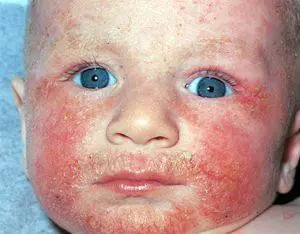
In childhood, neurodermatitis mainly occurs against the background of psycho-emotional shocks, gastrointestinal dysfunction, worms, disrupted daily routine and poor diet.
To correctly diagnose the disease, a visual examination is not enough. Clinical laboratory diagnosis is often required. If the following disorders are present, the presence of neurodermatitis can be assumed:
- increase in the level of immunoglobulins E;
- an increase in the number of eosinophils and leukocytes;
- decreased level of interferon type γ.
It is necessary to begin treatment of neurodermatitis in children by adjusting the diet. You should limit your intake of salt and spices, fats and fried foods. Sweets should be consumed in minimal quantities. It is better to exclude tea, coffee, soda, chocolate.
The second stage of therapy should be the elimination of the factors causing the allergic reaction. It is necessary to minimize the amount of dust in the house, limit contact with pets, etc.
If a child has a metabolic disorder in the body, he should take hepatoprotective drugs and enzymes.
If the above methods are ineffective, special therapy is necessary:
- antihistamines;
- sodium thiosulfate intravenously;
- hormonal agents;
- immunotherapy;
- vitamin therapy.
In individual cases, treatment with ultraviolet rays in small dosages is permitted.
How to avoid illness
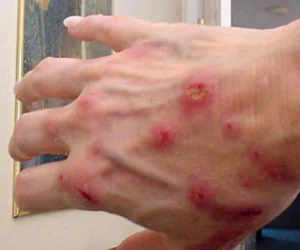
The best way to prevent disease is prevention. You should start by studying the history of the disease and the factors that provoked it.
If the cause of neurodermatitis is hereditary factors, it is difficult to avoid it, but by adhering to certain rules, you can significantly reduce the risk of relapse:
- you need to get up and go to bed at the same time;
- observe the intensity of physical activity on the body;
- learn to maintain psychological balance and avoid nervous tension;
- perceive life in a positive way.
The psychotherapist talks about the causes and symptoms of neurodermatitis, and also gives recommendations for treatment:
Did you like the article? Subscribe to site updates via RSS, or follow updates on VKontakte, Odnoklassniki, Facebook, Google Plus or Twitter.
Subscribe to updates by E-Mail:
Tell your friends!
Neurodermatitis: symptoms of the disease and treatment methods in children and adults: One comment
A very unpleasant disease... My sister encountered it and periodically suffers from relapses. No medications help her, she has a nervous disorder. As soon as he gets nervous, something like this immediately jumps up.



